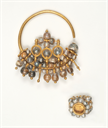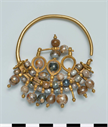Description
Pearls have a tendency to degrade in archaeological contexts. So, while they may be found in large quantities on objects from sacred treasures—liturgical furnishings and book covers, for example—they survive in considerably smaller numbers in private buried treasures. The fact, then, that more than one hundred pearls are preserved on these two pieces (BZ.1994.3.1 and BZ.1994.3.2) and the earring’s mate recently acquired by Dumbarton Oaks (BZ.2021.001) makes them the most splendid gold and pearl jewelry set to have survived from Byzantium. The variety of color—pale coral, light gray, dark gray, and brown—as well as the delicacy of the goldsmithing and sensitive ordering of the pearls further enhance the select quality of these pieces.
The wearing of jewelry in the tenth century might still have been colored by changing attitudes toward jewelry in the early Byzantine empire. In the fourth century, Church Fathers such as John Chrysostom and Gregory of Nazianzos condemned conspicuous consumption in the form of jewelry. Its importance in conveying status among the elite managed to ensure its continued existence. Jewelry carried such significance that it came to be governed by imperial law. The sixth-century law code of Justinian I decreed that “pearls, emeralds or hyacinths [sapphires] … [are] solely reserved for the splendor and adornment of the sovereign.” Furthermore, under threat of severe fine and even death, “no private person shall be permitted to make anything out of gold and jewels, which is reserved for imperial use and adornment (with the exception of ornaments usually worn by women, and the rings of both sexes)” [Corpus Juris Civilis 11.11.1]. This law would not have prevented a private citizen from wearing these pieces. At the same time, their dazzling opulence has led some scholars to speculate that they may have adorned imperial ears and fingers.
J. Hanson
Bibliography
R. Temple and J. Asfalg, Early Christian & Byzantine Art: Textiles, Metalwork, Frescoes, Manuscripts, Jewellery, Steatites, Stone Sculptures, Tiles, Pottery, Bronzes, Amulets, Coins and Other Items from the Fourth to the Fourteenth Centuries (London and Shaftesbury, 1990), 57-58, no. 12.
Gods, Beasts, and Men : Images from Antiquity, exhibition catalogue, Gerald Peters Gallery, Santa Fe & Dallas, Nov. 8, 1991-Feb. 1, 1992 (Santa Fe, N.M., 1991), 45.
Artemis Fine Arts Consolidated Audited Annual Report 93-94 (1995), no. 2.
M. C. Ross, S. A. Boyd, and S. R. Zwirn, Jewelry, Enamels, and Art of the Migration Period, Catalogue of the Byzantine and Early Mediaeval Antiquities in the Dumbarton Oaks Collection 2, 2nd ed. (Washington, D.C., 2005), 186-189, no. 190, pl. 122, colorpl. K.
G. Bühl, ed., Dumbarton Oaks: The Collections (Washington, D.C., 2008), 132, pl. p. 133.
A. Bosselmann-Ruickbie, Byzantinischer Schmuck des 9. bis frühen 13. Jahrhunderts: Untersuchungen zum metallenen dekorativen Körperschmuck der mittelbyzantinischen Zeit anhand datierter Funde, Spätantike, frühes Christentum, Byzanz: Kunst im ersten Jahrtausend. Reihe B: Studien und Perspektiven (Wiesbaden, 2011), 370, fig. 16.
Exhibition History
London, Temple Gallery, Early Christian & Byzantine Art, 1990.
Santa Fe & Dallas, Gerald Peters Galleries, Gods, Beasts and Men: Images from Anitquity, Nov. 8, 1991 - Feb. 1, 1992.
New York, International Antiques Show, 1991.
Maastricht, Antiques Fair, 1991.
Basel, International Antique Fair, 1991.
Dumbarton Oaks Museum, Cross References, May 26, 2011 - July 31, 2011.
Dumbarton Oaks Museum, 75 Years/75 Objects: Celebrating 75 Years of the Dumbarton Oaks Museum, September 8, 2015 - May 22, 2016.
Acquisition History
Collection of George Zacos (dealer), Basel, Switzerland, mid-1960's.
Collection of Athos Moretti, near Lugano, Switzerland.
Purchased from Robert Haber & Co., New York, (dealer) by Dumbarton Oaks Research Library and Collection, Washington, D.C., May 1994.
Dumbarton Oaks Research Library and Collection, Byzantine Collection, Washington, D.C.




